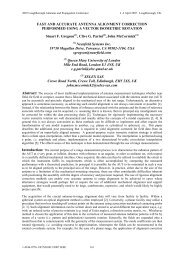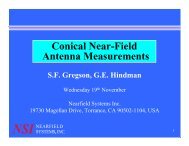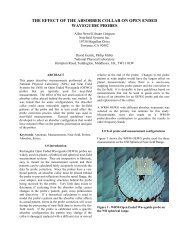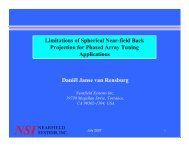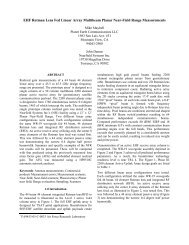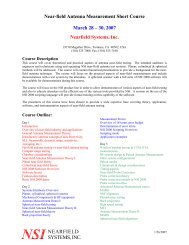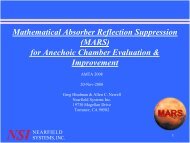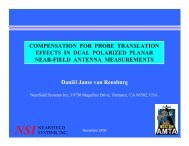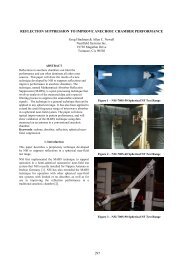Planar Near-Field Gain Measurements to Verify Calibration of ...
Planar Near-Field Gain Measurements to Verify Calibration of ...
Planar Near-Field Gain Measurements to Verify Calibration of ...
Create successful ePaper yourself
Turn your PDF publications into a flip-book with our unique Google optimized e-Paper software.
eference standard for these tests, and it is assumed that the<br />
gain <strong>of</strong> the horn has not changed since it was calibrated.<br />
The horn is a simple stable structure and if it is not<br />
damaged, the gain should remain constant. The electrical<br />
properties <strong>of</strong> the waveguide-<strong>to</strong>-coax adapter could change<br />
over time, but if it did, the input impedance would also<br />
change. The reflection coefficients <strong>of</strong> both the horn and<br />
the probe were measured and found <strong>to</strong> be nearly identical<br />
<strong>to</strong> the calibrated values.<br />
Figure 2 Dual-port probe on near-field range<br />
showing output connec<strong>to</strong>rs.<br />
The results <strong>of</strong> the three-antenna calibration are shown in<br />
Figure 3 and similar results were provided for a Standard<br />
<strong>Gain</strong> Horn (SGH) with an adapter from waveguide <strong>to</strong> APC-<br />
7 coax. The estimated uncertainty as shown by the error<br />
bars was ± 0.05 dB. The goal <strong>of</strong> the following<br />
measurements is <strong>to</strong> determine whether or not the gain <strong>of</strong><br />
the probe has changed by more than the estimated<br />
uncertainty <strong>of</strong> the original calibration.<br />
2.0 Measurement Approach<br />
The SGH that was calibrated with the probe is used as the<br />
8.3<br />
8.2<br />
Dual Port Probe <strong>Gain</strong> <strong>Calibration</strong><br />
Vertical Port<br />
Horizontal Port<br />
The SGH was mounted on the planar near-field range at the<br />
EMS Technologies Labora<strong>to</strong>ry in Sainte-Anne-de-<br />
Bellevue, Canada and the dual port probe was mounted on<br />
the probe carriage as shown in Figure 2. <strong>Planar</strong> near-field<br />
measurements were then performed with the horn polarized<br />
in the X or horizontal direction. The dual port probe was<br />
used <strong>to</strong> measure both the main and cross component nearfield<br />
data and the frequency was stepped over 9 frequencies<br />
identified by the location <strong>of</strong> the error bars in Figure 3. A<br />
sample <strong>of</strong> the near-field amplitude near the center <strong>of</strong> the X<br />
Relative Amplitude in dB<br />
0<br />
-10<br />
-20<br />
-30<br />
-40<br />
-50<br />
H-Cut for Y = 0<br />
V-Cut for X=0<br />
Probe <strong>Gain</strong> in dB<br />
8.1<br />
8<br />
7.9<br />
7.8<br />
7.7<br />
5.34 5.36 5.38 5.4 5.42 5.44 5.46<br />
Frequency in GHz<br />
Figure 3 <strong>Gain</strong> calibration curves for dual port<br />
probe measured at APC-7 connec<strong>to</strong>rs.<br />
-60<br />
-40 -20 0 20 40<br />
Probe X or Y Position in Inches<br />
Figure 4 Sample near-field amplitude data near X<br />
and Y centerlines for SGH .<br />
and Y scans is shown in Figure 4.<br />
The horn was then rotated about its axis by 90 degrees <strong>to</strong><br />
produce a Y or vertically polarized AUT. The near field<br />
scans were then repeated for the new orientation.<br />
At the completion <strong>of</strong> each <strong>of</strong> the two near-field<br />
measurements, the input cable was removed from the SGH<br />
and the output cables were removed from the probe ports.<br />
The input cable was then connected <strong>to</strong> each <strong>of</strong> the probe<br />
output cables <strong>to</strong> obtain the “Direct Connect” reading. This<br />
Direct Connect reading is essentially a calibration <strong>of</strong> the<br />
input signal level <strong>to</strong> the AUT and is required for the direct



